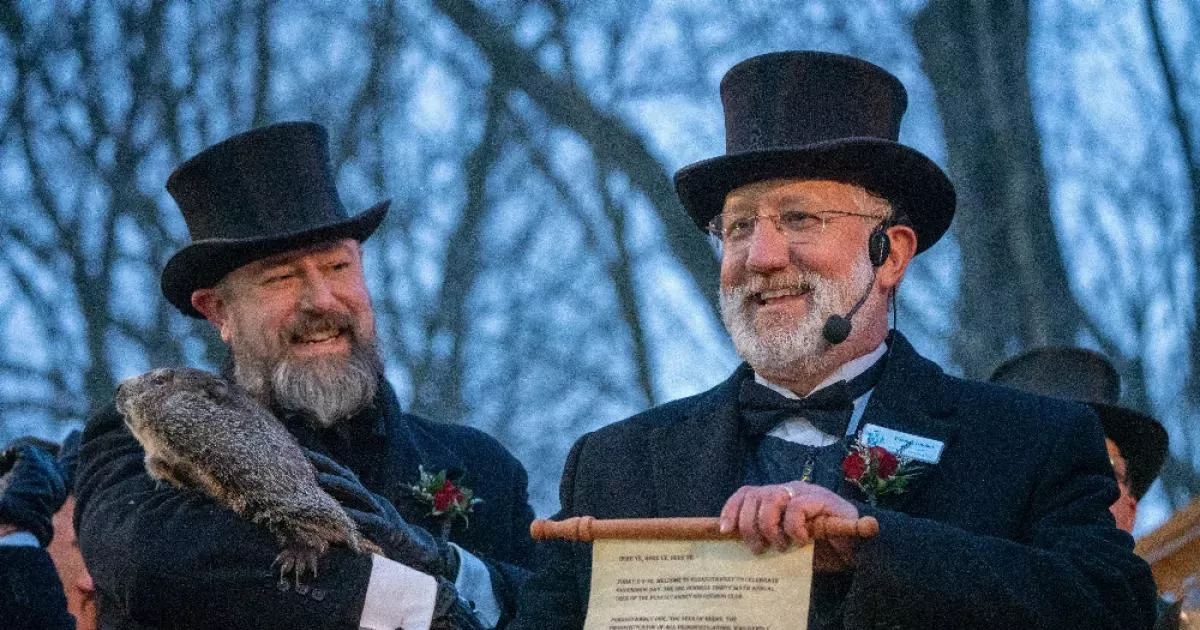Groundhog Day, observed annually on February 2nd in the US and Canada, is based on a Pennsylvania Dutch superstition. The tradition centers around whether a groundhog sees its shadow upon emerging from its burrow. If it does, it supposedly retreats and winter continues for six more weeks. If it doesn't see its shadow, spring is predicted to arrive early. In 2025, the groundhog saw its shadow, forecasting a longer winter.
1900: Publication on Hedgehog Predicting Winter
In 1900, Samuel Adams Drake's book mentioned a belief among Roman Catholics in Britain that the hedgehog predicted the length of winter.
1907: Formation of Slumbering Groundhog Lodge
In 1907, the Slumbering Groundhog Lodge was formed in Quarryville, Pennsylvania, and has carried out ceremonies using a taxidermic specimen.
1915: Groundhog Day Superstition Common in Dutch Pennsylvania
In 1915, it was documented that the weather superstition surrounding Groundhog Day was common to all fourteen counties in Dutch Pennsylvania Country.
1942: Death of Clymer Freas
In 1942, Clymer Freas, city editor at the Punxsutawney Spirit, considered the "father" of Groundhog Day, passed away.
1942: Punxsutawney Phil Sees Partial Shadow
In 1942, Punxsutawney Phil saw a partial shadow.
1943: Groundhog Day Canceled Due to World War II
In 1943, the Groundhog Day event was canceled due to World War II.
1946: Badger Day Tradition in Germany
In 1946, Rhys Carpenter emphasized the strong Badger Day tradition in Germany, noting its absence in the British Isles, suggesting this influenced the origin of Groundhog Day in the U.S.
1952: Sun Prairie Responds to Punxsutawney Spirit
In 1952, Sun Prairie, Wisconsin, proclaimed itself the "Groundhog Capital of the World" in response to an article describing it as a "remote two cow village".
1960: Dunkirk Dave's Beginning
Since 1960, Dunkirk Dave has been the local groundhog for Western New York, handled by Bob Will.
1961: Groundhog Named Phil
In 1961, the groundhog was first named Phil, possibly as a reference to Prince Philip, Duke of Edinburgh.
1968: Chuckles' First Prediction
In 1968, Chuckles, the woodchuck, began providing weather prognostication in Manchester, Connecticut, at the Lutz Children's Museum.
1969: Start of Accuracy Assessment Period
1969 was used as the starting point for assessing Punxsutawney Phil's accuracy, due to the reliability of local weather data from this year onward.
1978: Debut of French Creek Freddie
In 1978, French Creek Freddie, West Virginia's resident groundhog meteorologist, made his debut at the West Virginia State Wildlife Center.
1979: Rankin/Bass Release "Jack Frost"
In 1979, the Rankin/Bass holiday special "Jack Frost" featured Pardon-Me Pete, a groundhog whose shadow is manipulated. The special highlights the holiday's origins.
1987: Tradition at Shubenacadie Wildlife Park
Since 1987, Shubenacadie Sam has made the first Groundhog Day prediction in North America at Nova Scotia's Shubenacadie Wildlife Park.
1987: Publication of Les Misérables Translation
Victor Hugo's "Les Misérables" translated by Fahnestock and MacAfee, based on Wilbour, was published in 1987.
1993: Release of the Film "Groundhog Day"
In 1993, the film "Groundhog Day" starring Bill Murray and Andie MacDowell, was released. It grossed over $70 million and became a cult classic, significantly increasing awareness of and attendance at Groundhog Day events.
1993: Release of "Groundhog Day" Film
The film "Groundhog Day", set at the Groundhog Day festivities in Punxsutawney, was released in 1993, subsequently increasing attendance at the annual event.
1996: Malverne Mel Begins Prognostications
In 1996, Malverne Mel began his position as the groundhog of Malverne, Long Island, New York.
2008: Milltown Mel's Purchase
In 2008, Milltown Mel was purchased in Sunbury, Pennsylvania by Jerry and Cathy Guthlein.
2009: Fred la marmotte Becomes Forecaster
In 2009, Fred la marmotte of Val-d'Espoir became the representative forecaster for Quebec.
2009: Staten Island Chuck Bites Mayor Bloomberg
In 2009, Staten Island Chuck bit then-NYC-Mayor Mike Bloomberg, leading to a quiet replacement with his daughter Charlotte.
2012: First Appearance of Potomac Phil
In 2012, Potomac Phil made his first appearance at the Dupont Circle Groundhog Day event in Washington, D.C.
2014: Addition of Buffalo Bert
In 2014, Buffalo Bert was added as a groundhog in Buffalo, in jest, always predicting winter.
2014: Mayor de Blasio Drops Charlotte
In 2014, NYC Mayor Bill de Blasio dropped Charlotte during the ceremony, disturbing children. Charlotte's death a week later prompted rumors, and de Blasio stopped participating in the tradition afterward.
2015: Birmingham Bill Taking a Break
In 2015, Birmingham Bill at Birmingham Zoo was "taking a break" from predicting the weather.
2015: Jimmy the Groundhog Bites Mayor Freund
In 2015, Jimmy the Groundhog bit the ear of Mayor Jon Freund in Sun Prairie, Wisconsin, leading to a viral story. A mayoral proclamation later absolved Jimmy XI of any wrongdoing.
2016: End of Accuracy Assessment Period
2016 was the end date used to assess Punxsutawney Phil's accuracy, as assessed by Meteorologist Tim Roche of Weather Underground.
2018: Accusation of Collusion
In 2018, Potomac Phil was accused of collusion for consistently agreeing with Punxsutawney Phil's predictions.
2019: Potomac Phil Contradicts Punxsutawney Phil
In 2019, Potomac Phil contradicted Punxsutawney Phil's prediction and predicted two more years of political insanity.
2019: Assessment of Punxsutawney Phil's Accuracy
In 2019, the National Centers for Environmental Information placed Punxsutawney Phil's accuracy at 40% for the preceding ten-year period.
2019: Punxsutawney Phil's Prediction
On February 2, 2019, for the 133rd year of the tradition, Punxsutawney Phil did not see his shadow, predicting an early spring. Fans watched the event via a live stream provided by Visit Pennsylvania.
2020: Punxsutawney Population
As of 2020, the year-round population of Punxsutawney, Pennsylvania was 5,769.
2020: Great Neck Greta's Prediction
In 2020, Great Neck Greta of Great Neck, Long Island, New York, made her Groundhog Day prediction.
2020: Death of Winnipeg Wyn
In 2020, Winnipeg Wyn, who had been forecasting since the 2010s, died.
June 2021: Death of Western Maryland Murray
In June 2021, Western Maryland Murray died, leading to Queen City Charlie taking over ceremonies in western Maryland.
2021: Death of Milltown Mel
In 2021, Milltown Mel of Milltown, New Jersey died. The state has prohibited the procurement of a replacement groundhog.
2021: Lakehead University Study Assesses Groundhog Accuracy
In 2021, a Lakehead University study analyzed 530 predictions from 33 weather-predicting groundhogs, comparing them to the blossoming of the Carolina Spring Beauty wildflower. The study found groundhog predictions to be random, with an average accuracy of 50%.
2021: 135th Groundhog Day Celebration Held Behind Closed Doors
In 2021, the 135th Groundhog Day celebration was held behind closed doors due to the COVID-19 pandemic. On February 2, the groundhog saw its shadow, predicting six more weeks of winter.
2022: Sir Walter Wally's Retirement
After 2022, Sir Walter Wally of Raleigh, North Carolina retired, leaving Snerd of Garner as the only weather-predicting groundhog in the state.
2022: Groundhog Sees Shadow
In 2022, during the 136th celebration of the normal in-person event, the groundhog saw its shadow, predicting six more weeks of winter.
2022: French Creek Freddie Predicts Six More Weeks of Winter
On Groundhog Day, 2022, French Creek Freddie predicted six more weeks of winter, with the mayor of Buckhannon and community members present.
2023: Death of Fred la marmotte
In 2023, Fred la marmotte of Val-d'Espoir, the representative forecaster for the province of Quebec, died.
2023: Groundhog Sees Shadow
In 2023, during the 137th prognostication event, the groundhog saw its shadow, calling for six more weeks of winter.
2024: Chuckles Predicts Early Spring, Faces Consequences
In 2024, Chuckles predicted an early spring, but Winter Storm Birch soon followed. The local police department of Guilford, Connecticut issued a warrant for "Chuck the Liar". He "turned himself in" and was released due to his previous accuracy record.
2024: Groundhog Does Not See Shadow
In 2024, during the 138th prognostication event, the groundhog did not see its shadow, predicting an early Spring.
2025: Groundhog Sees Shadow
In 2025, during the 139th prognostication event, the groundhog saw its shadow, calling for six more weeks of winter.
Mentioned in this timeline
Nova Scotia is a province in the Maritimes region of...

The Woodstock Music and Art Fair held on Max Yasgur's...
Germany officially the Federal Republic of Germany is a Western...
Pennsylvania is a U S state located in the Mid-Atlantic...
Connecticut is a state in the New England region of...
Virginia officially the Commonwealth of Virginia is a state located...
Trending
12 days ago Zac Brown Band Releases 'Love & Fear' Album, Zac Brown Shares Childhood Story
Bitcoin is a decentralized cryptocurrency created in by the pseudonymous Satoshi Nakamoto Launched in it operates on an open-source platform...

5 months ago Driver Charged with 37 Counts of Attempted Murder After East Hollywood Car Ramming

14 days ago Josh Hart shines with increased workload, making a case to stay in lineup.

7 months ago Stock Market Climbs Amidst Moody's Downgrade and Debt Concerns: Key Takeaways

26 days ago NFL Week 12 Predictions: Colts vs. Chiefs, Cowboys, and potential season-shaping games.
Popular

Candace Owens is an American conservative political commentator and author...

Ilhan Omar is an American politician currently serving as the...

XXXTentacion born Jahseh Dwayne Ricardo Onfroy was a controversial yet...

Charles James Charlie Kirk was a prominent American right-wing political...

Michael Joseph Jackson the King of Pop was a highly...

Frederick Christ Trump Sr - was an American real estate...

